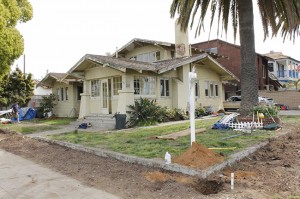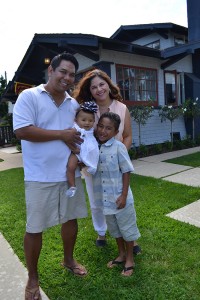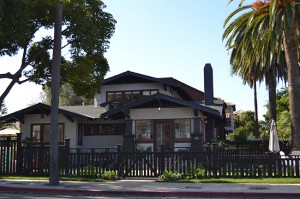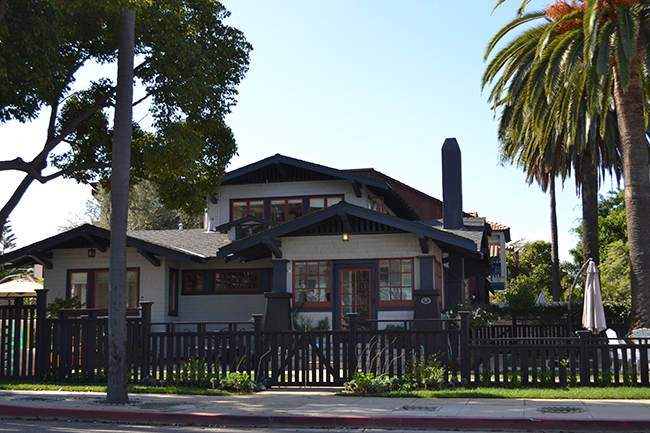When Chander and Jami Burgos bought a home directly across the street from North Island Naval Air Station in the spring of 2011 — the same year Coronado was celebrating its centennial as the birthplace for naval aviation — they had no idea of the home’s provenance. Their “Aeroplane Bungalow” had been built and owned by none other than Glenn Curtiss, whose Curtiss School of Naval Aviation had put Coronado on the international map in 1911 as the training ground for naval aviators such as Lt. Theodore Ellyson, the first aviator to take off from a Navy ship’s flight deck and named U.S. Naval Aviator #1.
No, the Burgoses were simply looking for something affordable. In Coronado. Not an easy combination, to be sure, but when they spied a run-down craftsman bungalow at Third and Alameda, they saw beyond the sagging eaves and a dreadful roof. They knew it was the perfect home for their growing family.
They recognized that the 100-year-old house was sorely in need of love and restoration, but they were undaunted, having been down that road before. Over the course of six years, they had restored a 1924 “Sears-kit” California beach bungalow in Huntington Beach.
“We looked at the house on Alameda and said almost in unison, ‘OMG! This is the house for us,’” said Chander, whose father had been a senior chief stationed at the former Naval Amphibious Base who had worked on numerous aircraft at North Island including the USS Ranger and USS Kittyhawk. “Every weekend I went with my parents to shop for groceries on base at North Island. I passed this house hundreds of times.”
Chander is an industrial systems engineer who had been part of the building team of Delta rockets for Boeing Corporation. After massive cutbacks to space programs, Chander now runs a company that specializes in manufacturing marine fenders for Navy ships, and he is a part-time professor at University of Southern California. Jami is a federal attorney. For work-related reasons, they found themselves moving back to San Diego, where they were excited to return to family and friends. The couple had grown up in Imperial Beach and the South Bay area and had been junior high sweethearts at Montgomery Middle School. Chander is a USC alumni and Jami attended Smith College.
Today, they are happily ensconced in their restored home with their son Chaden and daughter Demi. From his perch in the home’s second-floor solarium, Chander can spy his company’s product on ships docked at North Island. There’s even a connection with Charles Lindbergh, added Jami, smiling. “From the solarium, we can see the planes land and take off at Lindbergh Field.”
When they purchased the home in 2011 from the English family, the Burgoses had been told by Marla English that someone famous had built the property, and she believed it was a famed aviator by the name of Glenn Curtiss, but they would have to do some research.
But in Coronado, everybody knows everybody and it didn’t take long to unravel the riddle.
“One day, my brother-in-law, Paul Potter, a Coronado chiropractor was adjusting a client, Chris Ackerman, a local architect, and told him about our recent purchase. Chris asked for the address and ran to the building department and found the permit. He got in touch with Paul right away and he was so excited. ‘You won’t believe this! It’s true! Your in-laws’ home was owned by Glenn Curtiss!’”
A week later, Jami visited with Tricia Olsen, the city’s historic liaison for historically designated homes. She pulled all the records, including the original building permit, signed by Glenn H. Curtiss, and suddenly their bargain-priced home was a diamond in the rough.
In April 1912, Lena Neff Curtiss, Glenn Curtiss’ wife, purchased the entire west side of the 300 block of Alameda (at the time known as K Avenue) from the Coronado Beach Company for $10,000. There, Glenn Curtiss built not only his home to use during the winter months while operating his flying school, but also a home for his mother, Lua Curtiss. On June 12, 1912, an article was published on the front page of the San Diego Union to announce “the house was being built for Glenn Curtiss, aviator, for the price of $7,000.”
Lena Neff Curtiss also operated a photography business out of her mother-in-law’s home, just down the block.
Jami’s research uncovered that the original design for the house was to be a Spanish Arcade style, which is what Curtiss later built in Florida. “But I think there must have been an architectural firm, and I’m just guessing, who said, ‘Look around, this isn’t what fits in Coronado,’” she conjectured. “I think they suggested to him to build this type of bungalow, something that would better match the style of Coronado at the time.”
And maybe when the architect mentioned a style called ‘Aeroplane Bungalow,’ it just might have piqued Curtiss’ interest.
The Aeroplane Bungalow style was so named because of very large overhanging eaves, resembling airplane wings, and a small upper story resembling a cockpit with windows all around.
The 1,810-square-foot home of “eight rooms (three bedrooms, two baths) and a garage” features an amplitude of windows, upstairs and down, and an original Ostrich-foot tub in the upstairs bath. The bathroom’s original ornate gas wall heater is still intact, and the Burgoses plan to renovate it … someday. (“Right now, it sends out sparks,” Jami said.)
The floor plan includes a large main floor living room, separate dining room and a kitchen, which has been modernized, while still retaining an inviting wood table with banquet seating, surrounded by windows.
The original steam heating pipes are still intact beneath the house, and were once connected to North Island.
The Burgoses brought in their restoration crew from Huntington Beach, who had helped with their previous bungalow, along with many skilled relatives and friends. The work started with propping up the outlookers, which held up the eaves that had been drooping significantly. The chimney was falling apart and had to be rebuilt. The house was structurally sound, but needed a lot of work. Jami cautions potential renovators, “Do not take this on unless you really love restoring and living in an older home! As anyone knows who owns a much older home, the work is never done. We continue with restoration work little by little, being very careful to keep the original features of the house and the character of the craftsman design.”
When they purchased the house, only eight of the 29 casement windows were operable (17 are in pairs). The rest had been nailed shut. Most of the windows have been restored. They have added an updated kitchen and heating throughout.
For their efforts, the Burgoses obtained Historic Designation of the home in 2013, making it eligible for the Mills Act, reducing their property taxes in perpetuity, as long as the exterior elevations of the home remain intact (minor changes with city approval are permitted.)
Additionally, the Burgoses received a GEM Award from the Coronado Historical Association earlier this year, recognizing them for “Going the Extra Mile” in executing renovations that best reflect the island’s history and character.
As Jami gazed across Alameda at the entrance of North Island, she looked back in time. “This house was right in front of the Spanish Bight,” she mused. “There was water right here. Glenn Curtiss experimented with his airplane right here, right in front of the water.”
Chander chuckled, and added that he thought Curtiss was quite an astute businessman. “He sure knew how business operated,” he said. “There was a golf course (where the Country Club homes are today) and he played golf with his clients.”
“He was always drumming up business,” added Jami. Indeed, many of Curtiss’ clients weren’t just military; they were the well heeled who came on vacations to Coronado and could be enticed to take flying lessons.
“He built planes and his company eventually became part of the Curtiss-Wright Corporation,” said Chander. “He saw the potential for making money with the military by getting planes to land on ships and he was the first to do that. And he began building flight schools, here, in New York and Florida.”
Born in Hammondsport, N.Y., in 1878, Curtiss only completed eighth grade (not unusual for his era) then went to work to help support the family. His first job was for the Eastman Dry Plate and Film Co. (later to become Eastman Kodak Co.) where he invented a stencil machine, which was used at the plant. Another early job was as a Western Union bicycle messenger, which developed his interest in bicycles.
With his natural ability for mechanics and inventions, Curtiss began to tinker with bicycles, starting a business developing, building and restoring them. Always looking for a way to increase speed, he soon added motors to his bicycles, and by 1903 was one of the leading motorcycle builders in America. He began racing motorcycles, setting various speed records of the day, one of which was not broken until 1930.
In 1904, Curtiss was approached by Thomas Baldwin, who wanted a motor for his hot air balloon, which he flew at the St. Louis World’s Fair. With a Curtiss motorcycle engine, the California Arrow became the first successful dirigible in America. Eventually, Curtiss flew in the dirigible and developed an interest in human flight.
Curtiss joined the Aerial Experiment Association (AEA), a Canadian-American group funded by Alexander Graham Bell. Between 1908 and 1910, the AEA developed four aircraft, each one better than the last. Curtiss was the primary designer of the third aircraft, called the June Bug.
In 1908, Curtiss supplied the engine for the White Wing, designed by F. W. Baldwin and flew a distance of 5,090 feet, winning the Scientific American trophy for an unassisted take-off and a straight flight of at least a kilometer. The AEA, which had become the first group in America to design, build and fly airplanes, disbanded in 1909, and gave all its airplane designs and patents to Curtiss.
By 1910, Curtiss was well known as an innovator, daredevil and risk taker. With an eye to the country’s military needs, Curtiss was now interested in building planes that could take off from water and land on a platform. On Jan. 10, 1911, Curtiss came out West to compete in America’s first air meet at Dominguez Field in Los Angeles. Shortly after this event, he was wooed to San Diego to look at the possibility of opening a flight school. With its mild climate, open landing area and seclusion, North Island presented a perfect place for Curtiss to establish a school and conduct experiments. The Coronado Beach Company, owned by another kindred spirit, the always enterprising John D. Spreckels, gave Curtiss a permit to use North Island for a period of three years at no cost.
What followed over the next four years was one of the most prolific periods in the development of aviation, as the Curtiss School of Aviation conducted experiments and educated the nation’s first naval aviators. Coronado became the birthplace of naval aviation in 1911, and Curtiss later wrote of his early impressions:
“North Island, lying in San Diego Bay, a mile across from the city … is a flat, sandy island about four miles long and two miles wide with a number of good fields for land flights. The beaches on both ocean and bay sides are good, affording level stretches for starting or landing an airplane. Besides, the beaches were necessary to the water experiments I wished to make. North Island is uninhabited except for hundreds of jackrabbits, cottontails, snipe and quail. It joins Coronado by a narrow sand spit on the south side, which is often washed by the high tides. Otherwise, the two islands are separated by a strip of shallow water a mile long and a couple of hundred yards wide called “Spanish Bight.”
Curtiss operated his flying school and experimented with various types of airplanes, mostly developing a hydroplane that could take off on water and land on a platform aboard a Navy vessel.
He remained a leader in aviation and flight for several more years. Always the innovator, once he retired from aviation he moved to Florida and developed the first-ever motor homes. He passed away at the age of 52, the result of appendicitis and subsequent appendectomy.
Curtiss’s legacy lives on through his many innovations in motorized vehicles and aviation … and one Coronado Aeroplane Bungalow that will likely soar for another 100 years.






